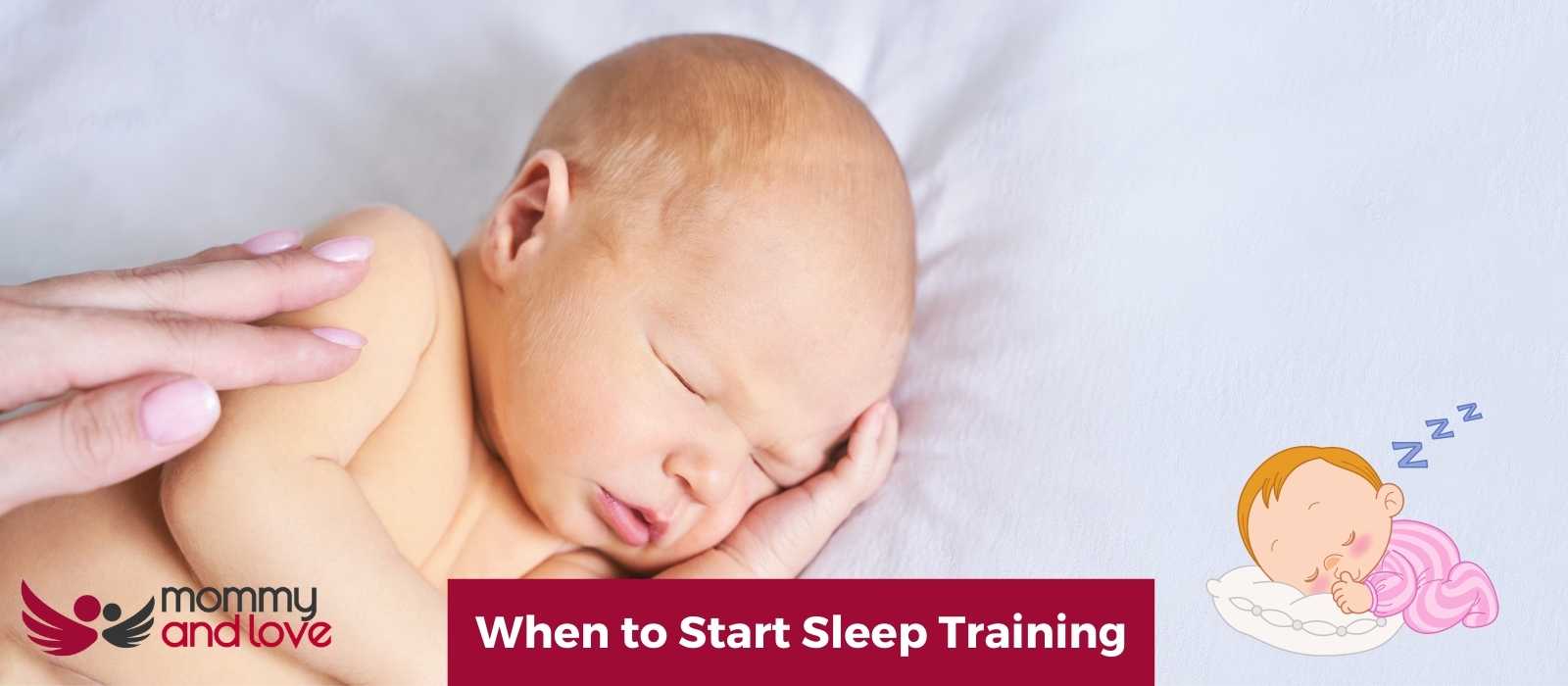It can be tough to know when the time is right to start sleep training your baby. Some parents may choose to wait until their child is a bit older, while others may begin sooner.
Sleep training can start when a child is around four to six months old in order to get them comfortable falling asleep on their own before the separation anxiety phase, which starts at around eight months of age.
What Is Sleep Training?

Sleep training is a way to help your baby develop the skill of falling asleep independently. This involves putting the baby down for bed while she is still awake, but drowsy and then letting her drift off without any assistance from you.
Sleep training also helps babies learn how to fall back asleep on their own when they wake up in the middle of the night. This is a normal part of the baby’s sleep cycle, even for adults.
Sleep coaching or sleep teaching can also improve parental mood of exhausted new parents and the infant’s sleep quality which is good for both you and your little one.
Sleep training is not synonymous with night weaning.
Is Sleep Training Safe?
Sleep training is a process that helps many babies learn how to fall asleep and stay asleep on their own. You can safely and effectively sleep train your baby as long as she is in a safe environment and is old enough.
When Is the Best Time for Sleep Training?

Sleep training can be a great way to help your baby learn to sleep through the night.
It is best to start sleep training when your baby is around four months old, as they are typically old enough to learn to self-soothe, and may no longer require night feedings.
Additionally, at around four months, your baby’s sleep cycles begin to mature and their circadian rhythm which is the hormonal cycle that regulates our sleep-wake cycles starts to take effect.
Sleep training can be started earlier for some babies and later for others, usually around 6 months, depending on their readiness. If you’re unsure if your baby is ready, consult with your pediatrician or a certified sleep consultant first.
How Long Does Sleep Training Take?
How long is a piece of string? But seriously, it can depend on so many factors. However, most techniques take around three or four nights of consistency for the child to get used to the new sleeping pattern.
However, the later you do it, the longer it may take as some bad sleep routines become ingrained.
How Do I Prepare for Sleep Training?
Sleep training can be a daunting process, but with the right preparation, it can be a lot easier. Here are some tips to help you get ready for sleep training:
- Make sure your child is developmentally ready. Most children are ready to be sleep trained between 4 and 6 months old.
- Choose the right time of day to start sleep training. It’s important to pick a time when you and your child are well-rested and can focus on the process.
- Set up a regular sleep training schedule and bedtime routine. A natural bedtime routine will help cue your child that it’s time to start winding down for the night.
- Putting your baby to bed while he’s awake but ready to sleep.
- Sleep training can take some time and effort, but it’s important to be patient and consistent with the process.
- Seek support from other parents. Connecting with other parents who have gone through sleep training can be a great source of support and advice.
- Rule out any underlying medical conditions that might interfere with sleep training. You can always talk to your pediatrician and review your baby’s behavior, sleeping patterns, and eating habits together.
- Keep a feeding and sleeping log. Having written notes will provide you with a better picture of your child’s sleep habits, feeding behavior, and responses to different stimuli.
- Create a safe sleeping environment for your baby. This means making necessary changes to your baby’s room to make it more conducive for sleeping.
- Pay attention to your baby’s sleep cues including business, constant yawning, and eye rubbing. Put her to bed if you notice any of the above cues.
What Are the Different Sleep Training Methods?
Sleep training is meant to help babies learn how to fall asleep on their own, without needing any assistance from you.
Here are some of the most common sleep training methods:
Cry It Out (CIO)
The cry-it-out method is a sleep training technique in which you put your baby to bed while they are tired but still awake so that they learn how to fall asleep on their own. Your baby may cry during this process, but it’s not necessary!
Make sure your baby has already been fed and is in a fresh diaper before putting him to bed. Also, check if the crib where he’s sleeping is safe.
Once your baby falls asleep, you don’t need to pick him up or take him out of the crib until morning or until his next feeding schedule.
The cry-it-out sleep training method can be difficult for parents but often works quickly. The first few nights are usually the roughest because babies are used to falling asleep with assistance, but they should improve rapidly after that.
Ferber Sleep Training Method
If you’re not a fan of letting baby cry, consider doing the Ferber method instead. The Ferber Method involves gradually increasing the amount of time you wait before checking on your baby until she falls asleep.
By gradually increasing the length of intervals between visits, you will help your baby learn to self-soothe and reduce the need for comfort checks. For example three minutes, five minutes, and ten minutes intervals after putting the baby down.
Parents should briefly say a word or two to their babies during these check-ins, such as telling them they love them or for them to sleep tight.
The Ferber Method has been shown to be an effective way to help babies learn to self-soothe and fall asleep on their own. However, it is important to keep in mind that every baby is different and some may not respond well to this type of sleep training.
Some babies might do better with timed check-ins, while others might get more upset when they see their parents coming and going.
Bedtime Fading Method
The Bedtime Fading Method is a technique used to help babies fall asleep at a different time than they are currently used to. This method involves gradually shifting your baby’s bedtime earlier by 15 minutes each night until you reach the desired time. This method is often used with other sleep training methods to help your baby get on a better sleep schedule.
Pick Up, Put Down Method
This sleep training technique involves you putting your baby to bed while she is still awake, but drowsy. If she cries, wait a few minutes before deciding whether or not to go in and soothe her. This will help her learn to self-soothe and fall asleep on her own. If the baby becomes agitated, try to soothe her before returning her to the crib.
This sleep training method can be a long process, but it requires patience.
Chair Method
The chair method also called sleep lady shuffle, is designed to help children fall asleep by gradually moving the chair further away from them over time. This teaches them to associate falling asleep with you not being in their line of sight, and also that even when you’re not visible, you’re still close by.
Every few days, move the chair a bit further away from your child until he or she is able to fall asleep without you being in their line of sight.
No Cry Method
Also called, the ‘No Tears Method’, is a way to help your child sleep better by subtly changing their habits. For example, if they always need rocking to fall asleep, you would rock them less and less until they can go to bed without any rocking.
Camping Out Sleep Training
The camping out sleep training method is based on extinction sleep training, which means you gradually wean out the night time feedings.
Additional Sleep Training Techniques

Remember that no matter what sleep training method you use, it takes a lot of patience and practice to sleep train a baby.
These additional sleep training tips can make the transition to a smoother good night’s sleep:
Every Baby Is Different.
There are different methods that might work for you and your baby – but don’t worry if one doesn’t seem to work right away. You may have to experiment a little bit to find what’s comfortable for everyone involved.
If sleep training becomes a total nightmare, don’t be afraid to bail out, and remember to combine methods to sleep train the baby if needed.
There is no one right way to sleep train your child, and different methods work for different kids. However, it’s important to be consistent once you find a method that works for your baby. This will help them learn the new skill more quickly and develop healthy sleep habits.
Establish a Bedtime Routine.
A baby’s sleep routine should be done consistently every day and started early enough that the baby will not become overtired.
If your baby falls asleep during breastfeeding or bottle-feeding, try scheduling those feeds before baths or bedtime stories so she will stay awake long enough to go to sleep.
Additionally, having a consistent bedtime routine can help your baby develop good sleep habits at a young age. It also helps babies sleep through the night.
Don’t Feel Like You Have to Respond to Every Little Noise or Cry From Your Baby.
Crying and fussing is to be expected when sleep training, no matter which method you use. However, as long as your baby is sleeping in a safe place, there’s no need to panic.
Learning sleep training basics is important for babies, as it will help them develop the skill of sleeping through the night. Once your baby has successfully finished sleep training, you don’t need to rock him until he fell asleep. Remember sometimes Newborn Squealing In Sleep and it means nothing at all!
Put Your Baby Down in Her Crib or Bassinet While She’s Still Awake.
Sleep training is based on teaching your baby to fall asleep without being rocked in your arms. This can be done by gradually transferring her from being held in your arms to lying down in the crib herself. If your baby cries when you put her down, read this guide.
Can You Sleep Train for Naps?
When it comes to sleep training your baby, you can use the same approach for naps as you do at night. However, keep in mind that if your baby cries for more than 30 minutes, they may only get a partial nap. So set a limit (for example, 10 or 15 minutes) on how long they are allowed to cry before trying another method.
Conclusion on When to Start Sleep Training
So, when can you begin sleep training? You can sleep train your baby when she reaches the age of 4 – 6 months.
Baby sleep training can be a difficult process, but it is important for babies to learn how to sleep through the night. There are different methods that can be used depending on what works best for you and your baby.
Be patient and consistent with whatever sleep training program or method you choose to get your baby sleeping through the night and remember that every baby is different.
FAQ on Baby Sleep Training
How Long Do You Let a Baby Cry It Out?
It is recommended that parents let their baby cry for about 45 minutes to an hour before bedtime, although the time may vary from child to child.
When Can Baby Self Soothe?
Babies cry a lot because it is their way of communicating with their parents. When they first start sleeping through the night, it is usually because they are learning to soothe themselves. Most babies learn how to do this around 6 months old when they try to go back to sleep after waking up in the middle of the night.

This article was written by: Gian MIller – Full-Time Writer, Baby Whisperer & Dad of 3.
Gian spends a lot of his time writing. A self-proclaimed baby whisperer, Gian has been through it all with his own children and is passionate about sharing his hard-won wisdom with other parents. When he’s not writing or changing diapers, you can find him playing the guitar or watching baseball (or preferably both at the same time).




